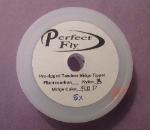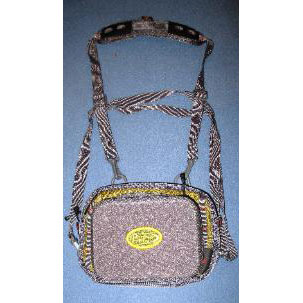Content
Streamer Fishing For Trout
Perfect Fly Pre-rigged Flies
Fly Fishing For Trout In Tailwaters
Featured Streams – Streams Of Great Smoky Mountains National Park
New Product
Streamer Fishing For Trout
Talking to anglers almost everyday of my life, I commonly hear concerns when it comes to fishing streamer flies. Some don’t even have a clue as to what foods some of them imitate. A wooly bugger is an old generic standby streamer fly pattern many anglers have heard of, yet few know what it food it was designed to imitate or for that matter, what species of fish it was intended to imitate. It was designed to imitate a hellgrammite, the large insect larva of the Dobsonfly. It is true that streamers require completely different techniques and presentations than dry flies, wet flies or nymphs. This is being written near the first of the Fall or Autumn season when streamers become even more important than during other times of the year and hopefully, it will answer a lot of questions and concerns many anglers have about streamers.
A streamer is designed and tied to imitate a “bait-fish”, or a smaller fish that larger fish generally feed on. Examples are sculpin, minnows, leeches, crayfish, and other foods fish feed on. They are fished with an active retrieve as opposed to a dead drift like many other presentations require. Movement of the fly is mostly caused by the angler stripping in line and in some ways resembles the way lures are often fished using casting and spinning tackle. Big fish eat little fish and streamers that imitate small fish often catch large fish. This is the main reason why streamers are a popular type of fly.
The best places to present streamers are areas where fish have some protection and where they can hide and ambush food. Example are undercut banks, behind large rocks and boulders, and around submerged logs or trees. They can also be effect in current seams and pockets of water. They are usually most effective when presented around cover or during times when the water is off color. They are effective in seams of current. A current seam is the sometime visible but more often an invisible line of the water where two speeds of the current meet. This often creates a small pocket of water where fish watch for food and conserve energy.
Streamers require a different type of cast than most other presentations. Casting methods vary depending on the weight of your fly. Streamer flies are usually heavier than other types of flies. You should always select a target prior to making the cast. Cast upstream and across. The fly needs time to sink to the right depth. Try to finish the cast with the rod tip up high. Most of the time, the streamer needs to be fished near the bottom, usually but not always, in the deeper water. Under turbulent flows there is usually calmer flows. Trout won’t hold in strong current. They will expend more energy than they can replace with food.
You need to get your fly down to their level. So, once your fly hits the water, let it sit for a few seconds. At this point, is usually helps to throw a downstream mend in your fly line. Cast across the stream close to the bank. Allow the current to assist by pulling the fly down near the bank. This is especially useful if the bank is deep or undercut. When the fly heads downstream, tilt your rod tip down to as low as it can get and even allow the tip of it to enter the water if needed. You want to keep it there while you strip in line. This allows the streamer to stay deeper during the retrieve. Small two to four inch strips will usually get the job done. Continue stripping in line until the fly is about to approach the end of its drift. Don’t work the fly back upstream against the current. Let it swing across the stream a few feet. Strikes often come at the end of the drift.
Well designed and tied streamers also have built-in action whereas the components of the fly move with the current as well as with the movement of the fly the angler adds. Most of our Perfect Fly streamers use materials that tend to move with the slightest amount of current. This just makes the fly appear more realistic.
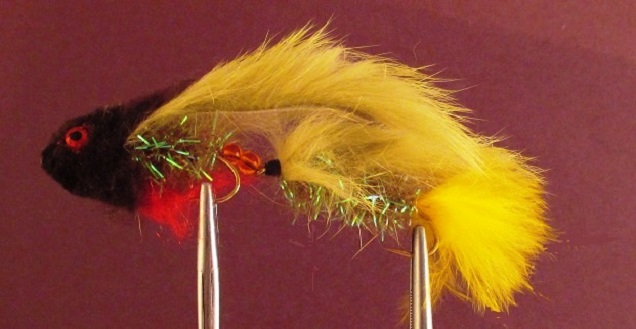
Many anglers get confused when it comes to selecting colors of streamers. First and foremost, they should match the item they are intended to imitate. Of course, different colors and clarity of water and sky conditions vary the way trout see the streamer. My rule of thumb is to use dark shades of the color of the item you are imitating when the skies are dark and/or the water off color, and to use light shades of the color of the item you are imitating when the skies are bright and the water clear. You want the fish to see the fly. You just don’t want them to see the fly well enough that they can detect it isn’t real or alive.
If you fish from a drift boat, presenting streamers requires some different tactics. Since the boat is going near the same speed as the current, a streamer presented as I previously described or up and across, would not swing down and across the same as it would when you are wading. You should cast the streamer upstream of but near the bank or other places with cover likely to hold fish and allow it to drift past the area likely to hold a fish. Some anglers use a strike indicator when presenting a streamer in this manner.
Retrieves can vary from a couple of hard strips and a pause, to a strip, pause, strip, pause type of cadence. If you are not catching anything, before you decide to tie on a different streamer, first try changing the cadence of the retrieve. Presentations need to change with different types of water as well as the type of fly you are using. Fast pocket water usually just gives you a chance to hit a spot and let it sink into the zone with a couple strips before the fly is out of the fish’s field of view. Other times you may be in slower moving water or water with overhead cover such as logs and it may work better to let the fly land just above the target and to let it drift into the strike zone. In deeper water or fast water, It is often critical to get your fly to sink quicker and swim deep all the way back to the boat. To do this in fast water, make a cast and immediately mend the line as it lands. It help to keep the rod tip deep in the water to help pull the sinking line down. This gets the fly deeper quicker and keeps the fly swimming deeper as you retrieve it back to the boat. Keep the fly coming all the way to the boat. Often a trout will hit it when you stop the retrieve very close to the boat.
Streamers for trout can be rather large, some as long at six to eight inches. It all depends on the particular type of food you are trying to imitate. Size range from those imitating small minnows to large bait fish, sculpin or leeches.
Rod sizes for streamer vary depending on the size and weight of the streamer as well as the size of the fish you anticipating catching. Six to eight weight rods are used mostly for trout. You want the rod to help you consistently deliver flies to the target with the least amount of effort. Casting streamers for a few hours is a lot like pure work. This is especially true when you are casting large flies and sinking lines for a long period of time. Heavier line weights tend to make the job easier. Fly line selection is often overlooked, but it’s just as important as choosing the right rod. When choosing a line for streamer fishing, consider the length of the average cast you will be making as well as how quickly the fly and line needs to sink after it hits the water? Will you be fishing fast deep water or fast shallow water? Will you be fishing slow moving deep water or shallow moving deep water. When choosing a line, it often pays to use running lines that don’t coil and tangle with sinking heads that deliver large flies to the target with as little effort as possible.
If you haven’t fished a sinking line, I suggest you practice it. It takes a little getting use to. In many cases, it helps to be able to make a haul cast. When you are fishing large flies and sinking lines, you don’t want to do much false casting. To get a fly down deep and quick, use a short leader. Leaders only three to five feet long are commonly used. This pulls the fly down with the line as it lands and swims. In many cases, longer leaders are best. This is true of streamers fished in shallow water. Tippet size depends on the stream flows and water clarity as well as the type of streamer being fished.
Perfect Fly Streamers for Trout
Great Lakes Steelhead Streamers
Perfect Fly Pre-Rigged Flies
I don’t know anyone who likes to rig flies while wading. I don’t know any who like to rig dropper rigs, double nymph or midge rigs while sitting on the bank. Most anglers pre-rig the flies at home or in their cabin, camper or motel/hotel room. In fact, I don’t really think many anglers enjoy rigging them anywhere and would much prefer to purchase them already rigged. We first started offering our midge larva and pupa pre-rigged on tippet whereas the larva is the bottom fly with the larva fly positioned about sixteen inches above the larva. That allows you to keep the larva fly on or near the bottom of the stream and the pupa fly above it imitating the the pupa accenting to the surface of the water. We include about two feet of extra tippet above the pupa fly so it can easily be tied to a leader. As a result, our midge sells rapidly increased. The pre-rigged midges are obviously very popular. We were able to keep the price low because our people have a set up that measures and cuts the tippet material for it that speeds the process up as compared to someone who just sits down and does the rigging. As a result of the popularity of the pre-rigged midges, we added other options. There is an option as to whether to use size 20 or 22 hook sizes of our Perfect Fly midge patterns. Another option is to choose from nylon tippet material or fluorocarbon.
After seeing the popularity of pre-rigged midges, we started offering pre-rigged double nymph rigs. They come with various combinations of nymphs. Noticing the increased popularity of dropper rigs, we decided to start selling pre-rigged dropper rigs. They come with a dry fly tied on about three feet of tippet material with an sixteen inch long extension of the tippet with a nymph which is the bottom fly. The come with several options of different dry flies and nymphs. These proved to be just as popular as the pre-rigged midges.
Pre-rigged Perfect Fly Midge Larva and Pupa
Fly Fishing For Trout In Tailwaters
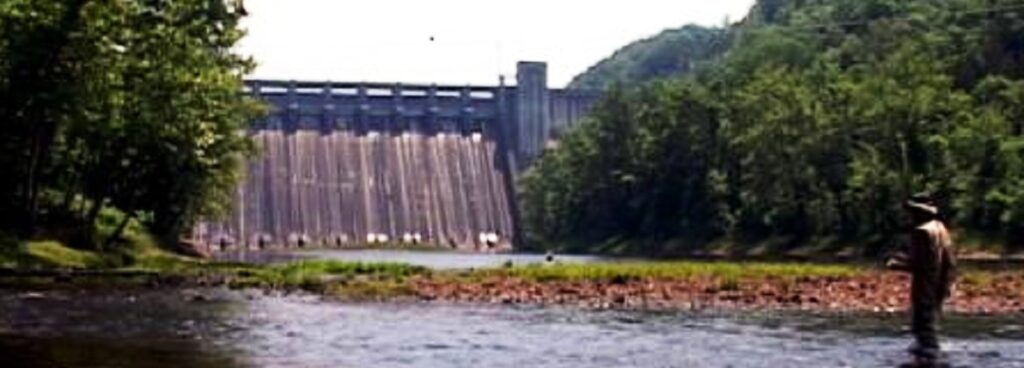
Trout streams are usually classified in three different categories, tailwaters, freestone streams, and spring creeks. Each of these different types of streams typically supports different amounts of oxygen, vegetation, and entomology. A tailwater is classified as a dam controlled section of water. The dam controls the flows and for the most part, water temperature. Dams are controlled by man and computers which typically regulate the discharges from the dam.
Finding fish in tailwaters requires some different approaches than finding fish in freestone streams. It is the same in the sense you want to look for are areas fish can hide and feed without spending more energy than they can replace with food. High flows results in swift currents that control where the fish feed. In many tailwaters, the first place you should look would be the banks, but tailwater banks vary greatly and that may not be the case in some situations. There are vertical banks with undercuts sections, plain vertical banks, sloping banks of varying degrees, shallow banks and deep banks. If you are floating a river, you may encounter different types of banks throughout the float. Banks with areas of depressions or cuts often provide good holding areas for trout. Some banks have heavy current and others almost still water. Some banks have rocks and boulders on them, others are slick and clear of anything. You want to fish the banks that have the most structure or cover for the fish to hide and ambush prey.
There are many other types of cover in tailwaters. Many have ledges out in the stream that are located various distances from the banks. Most of these type of areas are the old river bed banks. When the discharges are up, they are submerged and provide good holding places for fish to feed. Many tailwaters have bottoms with holes where fish can get out of the main current. Others have rocks and/or boulders that are underwater. They can provide protection from the current where the trout can hold and look for food coming downstream. Some tailwaters have grass beds that hold fish. Various types of vegetation can provide areas of good opportunity.
In many cases, especially on tailwaters not familiar to the angler, it is best to make long cast to the banks and fish them back to the boat or wading angler. This provides a way to cover lots of water in a short amount of time. In cases where the angler knows what cover and holding areas are located below the surface, it is wise to make more accurate presentations of shorter distances in order to cover the most potentially productive water. Sections of a river that are deep and wide have less current speed than those with shallow, narrow sections that has more speed.
Retrieves should vary depending on water color, stream flow, water temperature, and sky conditions. Again, you want the fish to be able to see your fly. You just don’t want them to see it well enough to realize it isn’t food. A hard strip and long pause technique allows you to fish tight to cover and along the contours of the river bottom. It also allows you to keep the rod tip deep in the water as the fly approaches the boat. Slow moving water provides a greater challenge than fast moving water. It is more difficult to fool the trout. In fast water, fish have a short time to respond when seeing a fly. It must respond quickly to catch the food. The fish respond quicker. When the fish can see the fly for a longer period of time in slower moving water, they get a much better view of the fly. They become more selective and less opportunistic.
Our Fly Fishing For Trout In Tailwater DVD covers the the special considerations that must be given to tailwaters in order for one to be consistently successful fishing waters where both man and nature can affect the conditions. The program covers a wide variety of streams across the U. S. from East to West, including scenes from over thirty blue ribbon tailwaters.
Fly Fishing For Trout In Tailwater DVD
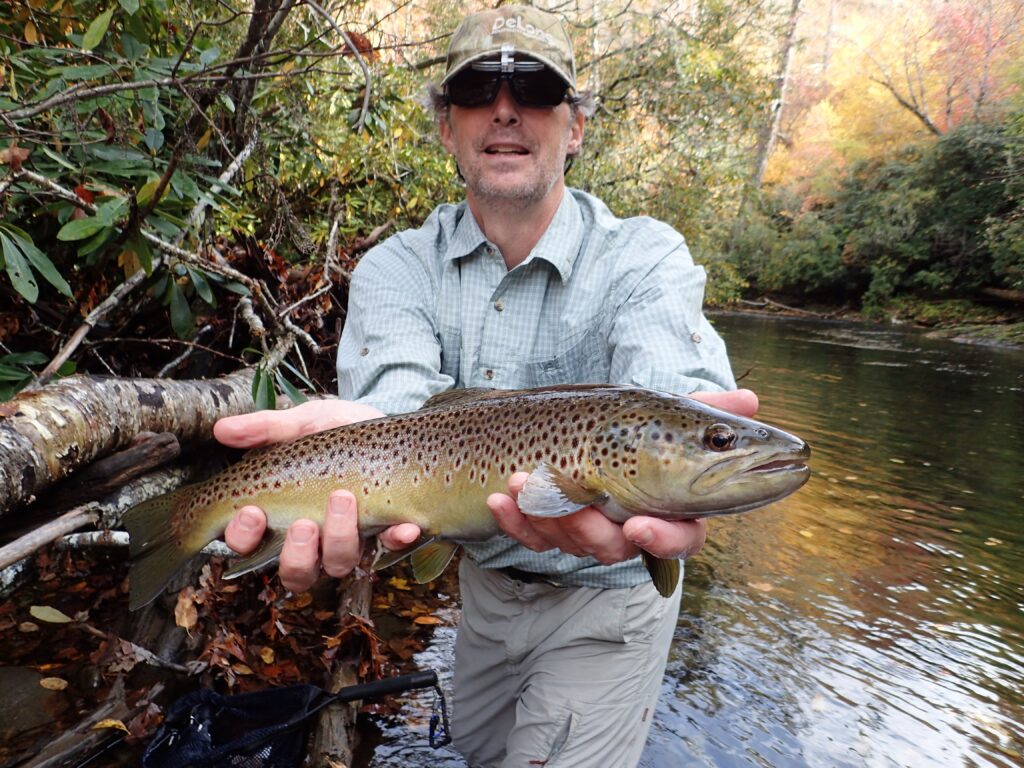
Featured Streams – Streams of the Great Smoky Mountains National Park
Even though Great Smoky Mountains National Park is the most visited National Park in the nation, many anglers are not aware that is has over 2900 miles of streams most of which offer excellent fly fishing opportunities. Many that are aware of that fact are not aware of the diversity of the fly fishing opportunity. There are two species of wild trout – the rainbow and brown trout. There is one native trout, the Appalachian brook trout. There are also smallmouth bass in the lower elevations of of some the streams. None of the streams inside the park are stocked. The park is located in both the states of North Carolina and Tennessee. Fishing license of either state work in the park regardless of the particular state you happen to be fishing.
The park is a part of the Appalachian Mountain Range that runs from Georgia to Maine. While the highest elevations are not as high as those of the Rocky Mountains, it doesn’t seem like there is that much difference. For example, if you fish the Rocky mountains from Denver, Colorado, you may fish at elevations up to 10,000 feet or so, but you are near the 6,000 ft or higher elevation when you start. That represents a 4,000 foot difference in elevation. In the park you may start depart to fish from Gatlinburg, Tennessee, at an elevation of about 1200 feet but fish brook trout streams that are over 5,200 feet in elevation. That is a 4,000 foot difference. In that respect, there isn’t that much difference in the two different locations.
There would be little benefit in my repeating many of the things already written in many pages of my website on fly fishing the smoky mountain park waters. All the streams are thoroughly covered. The fish species, streams that hold them and information specific to fishing for them are thoroughly covered. The tackle, gear, foods including the aquatic and terrestrial insects, flies to imitate them is covered. I don’t think we are missing any important information at all but if so, please let us know. I invite you to review the website, bookmark it and to take advantage of its year-round fly fishing opportunity.
www.flyfishingsmokymountains.com
New Perfect Fly Product
Waist Pack:
Waist Packs are alternates to the fly vest. The “Perfect Fly” Waist Pack is one that can carry almost everything a large fly vest can carry.The Waist Pack’s shoulder strap is very wide and padded so that it distributes the load equally and comfortably. The back has a strap for attaching a landing net. The waist pack can also be worn using the adjustable waist strap. Both the waist strap and shoulder strap can be used but either one of them will support it comfortably by itself. The back of the waist pack is ventilted so it stays cool and comfortable against your waist.
There is a foam fly storage compartment inside the front zippered pocket. It will hold up to 120 flies. The adjustable shoulder strap is wide and padded.It support the weight of the small waist pack comfortably. The adjustable waist stap also will carry the pack comfortably. Some pockets are lined with vinyl so they can be cleaned.
There are numerous places to attach about any device to the waist pack that you can think of or would ever need for fly fishing. They consist of various type of rings, eyes and retractable snaps.
Features:
Size: 6 x 9 x 21/2 inches
Zippered Compartments:
3 large ones. One folds down with a foam fly storage.
Vented Pocket
2 each
Shoulder Strap: Large Padded and Vented
Numerous places to attach various fly fishing items:
Includes 6 each straps plus a larger strap on the back of the pack. to attach many different types of items such as a fly floatant holder, tippet dispenser, etc.
Click to see additional Information on the Wader Lanyard
On Sale for $39.95, regular $59.95
